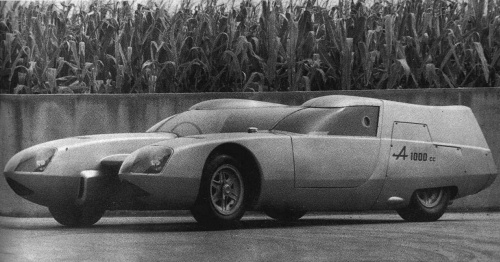
Looking more like a catamaran than a car, the Silver Fox is unique. This is the second attempt – dated 1967 – to participate in a bisiluro at the 24 Hours of Le Mans. Designed by Ing.Sergio Sartorelli and manufactured by Turin's OSI – Officine Stampaggi Industriali (one of many extinct Italian craftsmanship and industrial excellences), the car, also built to achieve certain speed records over the distance, unfortunately had no way to express its potential due to the sudden death of the OSI's co-owner, Eng.Luigi Segree, and the subsequent shutdown, in 1968, of the company's activity began only 8 years earlier.
However, due to the financial situation, Osi found himself in this dream which was never realized. Instead, we end up with a unique car.
The car is in two parts bordered by the passenger compartment, the Alpine 1000cc engine sits behind the left seat, with the spare wheel etc. behind the other.
Since nothing is between the wheels, the space instead houses three aerodynamic wings. The front being to stabilize the car, the second being the cockpit and the third holding the brakes and the differential/drive.
Aerodynamics: the Silver Fox had more square lines than in the past, probably also in homage to the styling features then in force. The great care taken in the design and the careful study of the aerodynamic flows produced a very well profiled body, characterized by avant-garde solutions at the time, from the two truncated tails with a slightly raised tendency to the study of the flows of current between the two hulls on which it is worth lingering.
The front wing element present in the “Tarf II” has been updated on the Silver Fox by widening its surface and placing it in a position just behind the front axle; the subtlety of this horizontal wing minimized the division of the flows which were channeled under the central pavilion whose lower profile began just below the attachment of the windscreen and descended slightly towards the tail.
The flow, sliding under the windshield, was thus directed towards the rear of the car and, impacting on the load-bearing fairing of the central element of the rear frame, pushed the rear axle towards the ground, thereby increasing its grip: in practice, a much more extensive lower rear wing but with a function completely similar to that, seen later, that characterized the tail of the Fiat Barchetta.
The Silver Fox, despite the impossibility of honoring the objectives for which it was built, sealed an era of profound transformation of design and industrial processes, an era in which not yet constricted by the logic of the market, the budget and diagrams, a reality on the whole semi-artisanal because the OSI could translate flashes of genius into reality.
.png)
























Comments